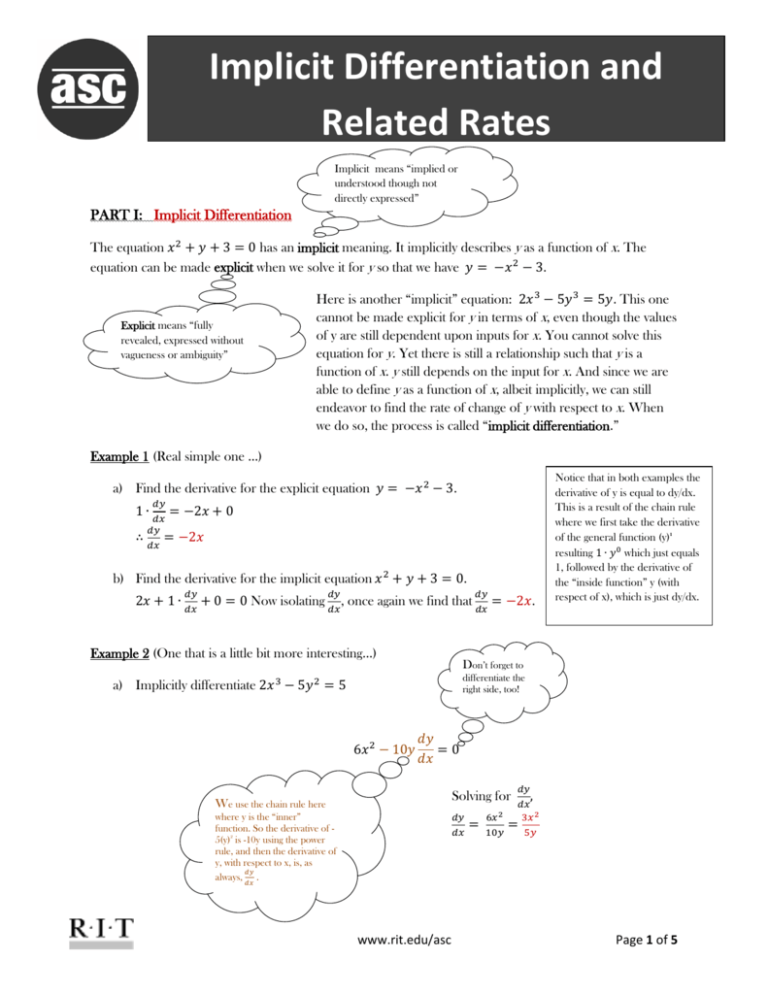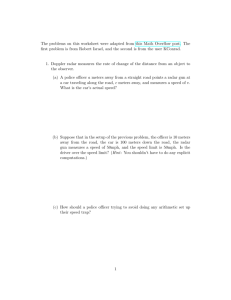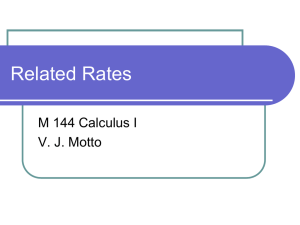Implicit Differentiation and Related Rates
advertisement

Implicit Differentiation and Related Rates Implicit means “implied or understood though not directly expressed” PART I: Implicit Differentiation The equation has an implicit meaning. It implicitly describes y as a function of x. The equation can be made explicit when we solve it for y so that we have . Here is another “implicit” equation: . This one cannot be made explicit for y in terms of x, even though the values of y are still dependent upon inputs for x. You cannot solve this equation for y. Yet there is still a relationship such that y is a function of x. y still depends on the input for x. And since we are able to define y as a function of x, albeit implicitly, we can still endeavor to find the rate of change of y with respect to x. When we do so, the process is called “implicit differentiation.” Explicit means “fully revealed, expressed without vagueness or ambiguity” Example 1 (Real simple one …) a) Find the derivative for the explicit equation . Notice that in both examples the derivative of y is equal to dy/dx. This is a result of the chain rule where we first take the derivative of the general function (y) resulting which just equals 1, followed by the derivative of the “inside function” y (with respect of x), which is just dy/dx. 1 b) Find the derivative for the implicit equation Now isolating . , once again we find that Example 2 (One that is a little bit more interesting…) . Don’t forget to differentiate the right side, too! a) Implicitly differentiate Solving for We use the chain rule here where y is the “inner” function. So the derivative of 5(y)2 is -10y using the power rule, and then the derivative of y, with respect to x, is, as always, . www.rit.edu/asc Page 1 of 5 b) Now find the equation of the line tangent to the curve expressed by at the point (2, -1). ( ) ( ) ( So, starting with the point-slope form of a line ( ) ) ( ), Example 3 Find the equation of the line tangent to the curve expressed by at the point (2, -2). Implicit differentiation is needed to find the slope. Therefore [ ] ( ( Product rule is used on Chain rule is used as shown in examples above. ) ) Hence, the tangent line is the vertical line Example 4 for 5 = Find [ ] [ . Using the quotient rule we get ( )( ( ) ( ] ) )( )( )( Now you try some: 1. Find ) by implicit differentiation. a) [ ] Hence [ Or 2 2 b) 3x 5xy 7 xy 2 y 1 ] [ 2 x y 25 3x 2 y sin xy c) e d) sec( x y) x y ] 2 3x 3 2. If 4 x 4 xy 2 y 140 find the equation of the tangent line at (-1,4). 2 3. If 4 x 5 x xy 2 and y(2) = -12, find y’(2). www.rit.edu/asc Page 2 of 5 STEPS: 1. As you read the problem pull out essential information & make a diagram if possible. PART II: Related Rates Related rates problems can be identified by their request for finding how quickly some quantity is changing when you are given how quickly another 2. Write down any known rate of change & the rate of change you are looking for, e.g. dV 3 & dt variable is changing. There exist a few classic types of related rates problems with which you should familiarize yourself. 1. 2. 3. 4. 5. dr ? dt 3. Be careful with signs…if the amount is decreasing, the rate of change is negative. The Falling Ladder Optimization The Leaky Container The Lamppost and the Shadow The Flying Object 4. Pay attention to whether quantities are fixed or varying. For example, if a ladder is 12 meters long you can just call it 12. And if a radius is changing a changing rate, just call it r. You will plug in values for varying quantities at the end. 6. Set up an equation involving the appropriate quantities. Example 1: “The Falling Ladder” 7. Differentiate with respect to A ladder is sliding down along a vertical wall. If the ladder is 10 meters long and the top is slipping at the constant rate of 10 m/s, how fast is the bottom of the ladder moving along the ground when the bottom is 6 meters from the wall? 8. Plug in known items (you may need to find some quantities using geometry). t using implicit differentiation. 9. Solve for the item you are looking for, most often this will be a rate of change. 10. Express your final answer in a full sentence with units that answers the question asked. SOLUTION: 10 meters The relevant equation To find the height of the ladder when the bottom of the ladder is 6 meters from the base of the building, we use the Pythagorean Theorem. yields y = 8. when x = 6 meters here is the Pythagorean Theorem: height is y Note that the base is x and the is our equation. Implicitly differentiating this yields Plug in all known values. Hence, ( ) ( )( ) m/s www.rit.edu/asc Page 3 of 5 Example 2: “The Leaky Container” Gas is escaping from a spherical balloon at the rate of 2 cubic feet per minute. How fast is the surface area shrinking when the radius of the balloon is 12 feet? [Note: 1 ft3 = 7.5 gallons] r r SOLUTION: First, we identify the related rates, that is, the two values that are changing together - the change of volume and the change of the surface area (V and SA respectively) and state the formula for each: Therefore, beginning with and we take the derivative of each to obtain the change of rate for each: So we have: ( (1) and We are given ( and we are looking for So how do we find ) ) (2) . If we knew the value of , then we would be done. ? We look at what we are given and what we now need to know. Using equation (1), and the fact that we are given values for the change of volume and the radius, we find that . Now, the known information into equation (2), we obtain ( ) ( )( ) ft/min Example 3: “The Lamppost and the Shadow” A boy 5 feet tall walks at the rate of 4 ft/s directly away from a street light which is 20 feet above the street. (a) At what rate is the tip of his shadow changing? (b) At what rate is the length of his shadow changing? www.rit.edu/asc Page 4 of 5 SOLUTION: I am traveling at a rate of 4 ft/s to the right. 20 ft 5 ft x ( y ) Hence The setup for this problem is similar triangles. The tip of the shadow is at the end of the base x + y. Let . The related rates for part (a) are the boy’s walking and the rate the tip of his shadow is changing, and , respectively. Note that ( ) shadow, and . Differentiating both sides yields ft/s. The related rates for part (b) are the boy’s walking and the length of the , respectively. Differentiating yields ( ) ft/s. Now you try some: 1. If a 2 2 2 b 4b c , db dc da when b = 1 and c = 2. 2, 3 , find dt dt dt (Assume a > 0) 2. A boat is pulled by a rope, attached to the bow of the boat, and passing through a pulley on a dock that is 1 meter higher than the bow of the boat. If the rope is pulled in at a rate of 1 m/sec, how fast is the boat approaching the dock when it is 8 meters from the dock? 3. A cylinder with a height of 5 ft and a base radius of 10 in is filled with water. The water is being drained out at a rate of 3 cubic inches per minute. How fast is the water level decreasing? 4. A 13-foot ladder propped up against a wall is sliding downward such that the rate at which the top of the ladder is falling to the floor is 7 ft/sec. Find the rate at which the distance between the bottom of the ladder and the base of the wall is increasing when the top of the ladder is 5 ft from the base of the wall. 5. A street light is mounted at the top of a 12 ft pole. A 4 ft child walks away from the pole at a speed of 3 ft/sec. How fast is the tip of her shadow moving? 6. A 12-foot ladder is propped up against a wall. If the bottom of the ladder slides away from the wall at a rate of 3 ft/sec, how fast is the measure of the angle between the bottom of the ladder and the floor changing when the angle between the top of the ladder and the wall measures /3 radians? www.rit.edu/asc Page 5 of 5





